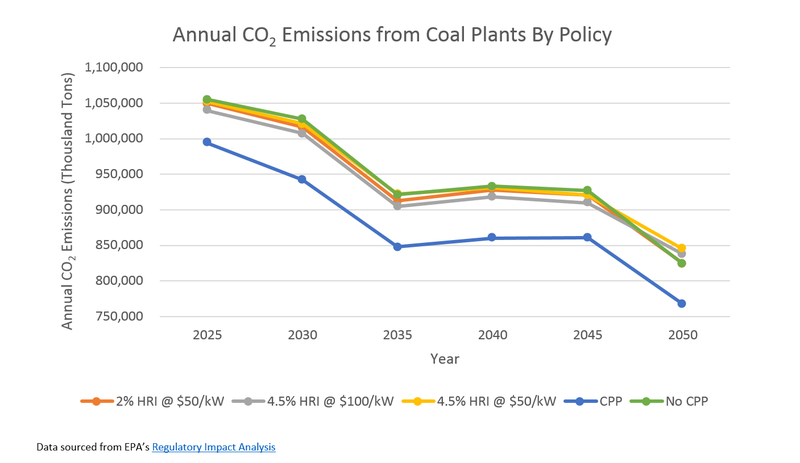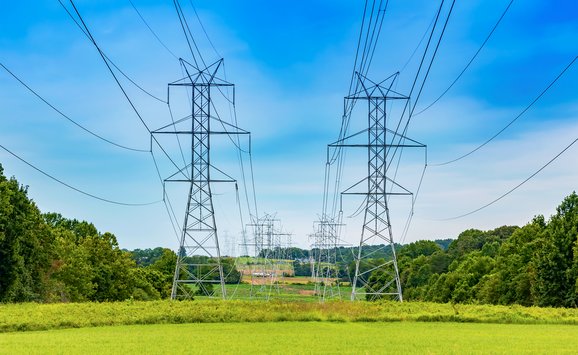This blog follows up on an earlier post from August 30.
The Environmental Protection Agency’s (EPA’s) regulatory impact analysis (RIA) of the Affordable Clean Energy (ACE) rule proposed on August 21, 2018 reveals the plan’s insufficiency in reducing carbon dioxide (CO2) emissions. Framed as a relatively cheaper and less stringent replacement of the Clean Power Plan (CPP), ACE would raise greenhouse gas emissions annually in every projected year relative to the CPP. EPA justifies this fact in the RIA by citing lower compliance costs and sector-wide annual emissions reductions compared to a No CPP (business-as-usual) case. However, the RIA fails to address the very limited decline and, in some cases, increases in emissions from coal plants specifically relative to a No CPP case.
As shown in the plot above, heat rate improvements (HRI) barely reduce emissions from coal plants compared to a No CPP case. In fact, by 2050, the 4.5 percent HRI at $50/kilowatt (kW) and the 4.5 percent HRI at $100/kW cases would actually result in higher annual emissions compared to the No CPP scenario. Most notably, a stricter standard of 4.5 percent HRI results in more emissions than a 2 percent HRI at the same price ($50/kW). This is likely due to the rebound effect where more efficient plants become more economically competitive and therefore operate more frequently (discussed in greater detail here). The 4.5 percent HRI at $100/kW results in greater emissions reductions (between 1.5 and 2 percent compared to No CPP) than the other cases only because the higher price deters more plants from adopting the technology, and they opt to retire instead. These results indicate that the technology itself does little to reduce emissions, and substantial reductions only occur when plants shut down altogether.
These already modest emission reductions are based on assumptions that fail to account for several essential components of the proposed rule itself. For example, instead of accounting for the uncertainty associated with state-level standard setting, the RIA bases emissions estimates on economy-wide standards with the assumption that impacted coal plants will either comply with the standard or retire. In reality, the standards will vary across states with some being much more lenient than others. By 2021, the model predicts that between 46 and 50 gigawatts of coal units will retire due to HRI policies. If state standards are more lenient than the HRI’s modeled, fewer plants would likely retire, resulting in higher emissions.
In addition to these internal modeling flaws, the RIA assumptions are at odds with efforts elsewhere in the Trump administration to slow the retirement of coal plants in the name of system resilience and national security. According to the RIA, these projections entirely exclude any coal plants with planned retirement dates prior to 2024 since the ACE compliance period is not expected to begin until 2025. In an earlier post, we discussed the possibility that federal energy policies might extend the lifetimes of these coal plants. According to the NEEDS V6 database used in ACE modeling, approximately 36 modeled coal units comprised of over 8,500 megawatts plan to retire between 2019 and 2024, none of which were included in the analysis. If federal policies prevent these modeled units from retiring, they would cumulatively produce an estimated nearly 40 million tons of CO2 annually assuming a 53.5 percent capacity factor (based on EIA coal plant average from 2017) and a 4.5 percent heat rate improvement at all plants. Given that the RIA estimates CO2 emissions reductions between 13 and 30 million tons compared to a No CPP case by 2025, the extended lifetime of these plants, even under the most aggressive HRI assumptions, could certainly result in higher emissions relative to a No CPP scenario. Furthermore, the heat rate improvements for these older plants could cause them to run more than they have in the recent past. Thus, the rebound effect associated with the ACE rule could be further magnified when coupled with these federal policies keeping coal plants online.
ACE alone shows such a minor reduction in emissions primarily due to 1) the overall lack of regulatory stringency, and 2) the rebound effect resulting from efficiency improvements. When coupled with modeling inconsistencies, ACE looks even worse. Most importantly, the combination of ACE and federal energy polices to promote coal could exacerbate the rebound effect by keeping more coal plants online. In sum, the combination of these recent federal climate policy and energy policy proposals could very likely increase emissions relative to business-as-usual.






